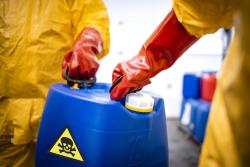Providing innovative, tailored and nuanced strategies to address the tensions between circularity and pollution.
The circulation of hazardous substances presents a significant risk to the development of sustainable
industries, human health, and global ecosystems. As Australia and other nations move further towards
greater product stewardship and a circular economy, new concerns are emerging related to the circulation of hazardous substances into second-life products through recycling, and the accumulation of legacy chemicals in natural environments and human bodies.
Data is emerging showing industrial chemicals entering food chains, waterways and human bodies through various pathways. Some substances, such as highly toxic and environmentally persistent PFAS (per- and polyfluoroalkyl substances) have been found leaching from products including non-stick cookware, textiles, furniture and food packaging across the supply chain, putting the health of workers and consumers at risk.
In addition to the health risks posed, substances of concern are estimated to cost businesses and resource recovery industries billions of dollars each year in lost revenue and significantly undermine public and business trust in the circular economy. Research has shown that hazardous chemicals are holding back a circular economy for food and garden organics, fashion and textiles, electronic waste, food packaging and other industries.
To create a sustainable, socially just, profitable and safe circular economy, the tensions between circularity and pollution will require innovative, tailored and nuanced strategies.
ISF is interested in meeting this challenge through research that involves:
- Characterising the risks of the circulation of hazardous substances for specific industries
and supply chains: how do the challenges differ between industries? In what cases is it still
necessary to use hazardous substances and how can they be prevented from circulating? - Identifying opportunities to remove non-essential hazardous substances from supply chains
through design: how can the concept of ‘essential use’ be applied to different types of products?
What is the best approach when safe substitution is not possible? How can product and service
design enable safer products? - Seeking enablers for improvements in safe design for circulation: How are design decisions
made? What are the knowledge transfer and communication challenges? Are there regulatory
measures that could help support safe design? - Examining how circulation should be governed and how conflicts between material
circularity and health should be handled: how can tensions and conflicts between the values of circularity, Net Zero, safe design and profitability be negotiated when they emerge? What types of
governance strategies and decision-making approaches might be effective? - Providing frameworks and tools to help decision-makers in government and industry create
clean material cycles: What approaches can be adapted or developed to help decision-makers
navigate complex data, tensions, and stakeholder interests? - Investigating mechanisms for tracking, tracing and accountability: what methods could be used
to improve material traceability, communication along the supply chain and material accountability
for different industries?
PROJECT | 2024
Toxic-free childcare guide
A practical guide to making Australian childcare centres and preschools safer.
PROJECT | 2022
Synthetic turf in public spaces – chemical composition of materials
What is the impact of synthetic turf on the safety and amenity of open spaces? The NSW government is investigating the impact of synthetic turf on the safety and amenity of open spaces.
WHITE PAPER | 2022
Product stewardship and chemicals of concern: Challenges and strategies
Taking responsibility for hazardous chemicals along supply chains is an integral part of product stewardship. However, a number of challenges including lack of transparency, inadequate and inconsistent regulation, and lack of knowledge mean that many chemicals of concern remain in products.
This white paper outlines some of the key challenges associated with chemicals of concern and product stewardship and considers a few of the strategies being employed by government and industry to address them.
Partner: Product Stewardship Centre of Excellencce
Researchers: Rachael Wakefield-Rann
RESEARCH OUTPUTS
Product stewardship and chemicals of concern: Challenges and strategies (2022) (White paper)
PROJECT | 2017-2018
Chemical management for consumer products
This report addresses the need for an improved understanding of best and worst practices in the use and management of potentially hazardous chemicals in consumer products.
It characterises the industry landscape and identifies the main areas for improvement in the management of hazardous chemicals by companies across core segments of the consumer product market internationally. The study looked at companies that supply personal care products (cosmetics, oral care, hair care, sunscreens, soaps and skin creams); home care products (laundry, cleaning and air fresheners); pesticides and insecticides (for home use only); paints (for home use); adhesives and sealants (for home use); ingredients (fragrances).
In addition to providing insights into the state of industry awareness and action, the report presents an evaluation framework for investigating not only if companies are using potentially hazardous chemicals, but also the mechanisms they have in place to respond to new knowledge about hazardous chemicals, the extent to which they employ a precautionary approach, the transparency of information, and their engagement with and awareness of hazardous chemical management along the entire supply chain. The report concludes by offering steps forward for government and industry to improve the management of hazardous chemicals along the supply chain and recognise its significance as a core aspect of sustainable and responsible business.
Partner: Ascend Waste and Environment Pty Ltd
Researchers: Damien Giurco, Rachael Wakefield-Rann
PHD RESEARCH | 2023
Hannah Mullen:
Investigating whole of supply chain approaches to environmental stewardship for textiles, with a particular focus on nano-silver.
PHD RESEARCH | 2023
Sarah Wilson:
Exploring governance mechanisms for emerging technologies though the case of Quantum Dots.
MEDIA
Unlocking quantum frontiers – ISF News, Feb 2024
Researchers
-
Research Principal
-
Research Director
-
Research Director
-
Senior Research Consultant











